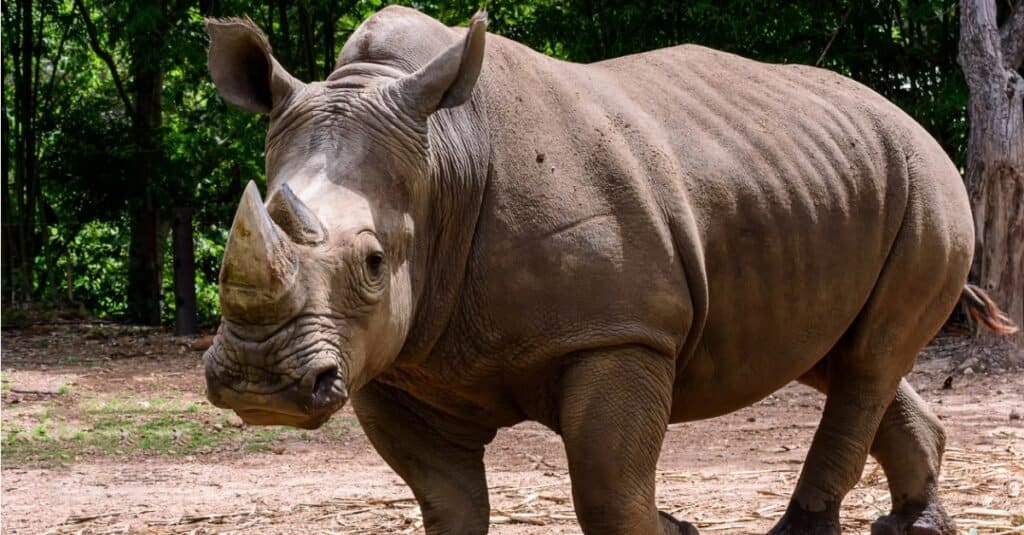
A variety of rhino species are rare and places like White Oak are working hard to increase the population.
©iStock.com/nuwatphoto
With increased poaching and land thinning, many species of endangered animals are becoming more and more rare with each passing day. Some of the numbers are truly heartbreaking. While many might not be sure how to help slow down this staggering problem, the White Oak Conservation Center in northern Florida is working hard to protect rare animals.
About White Oak
White Oak Conservation, a state-of-the-art scientific education and conservation center, focuses on recovering and saving rare species populations. Further, they research animal health, call on experts, and educate the future generation of conservation experts.
Settled on 17,000 riverfront acres, the facility provides a refuge for more than 17 endangered species. The conservation center offers tours to view the endangered wildlife and learn what steps are being taken to help increase the numbers of all these species.
White Oak is widely respected by fellow conservationists for the company’s work in both protecting and propagating rare animals. The company completes its work in both the United States and beyond the borders. Furthermore, the company partners with state agencies. They also partner as well as the federal offices, which include the US Fish and Wildlife Service.
A few key facts about the company:
- Offering 125 years of wildlife management experience
- Over 500 animals have been housed
- 30 species cared for over the years
- Wildlife facilities and conservation habitats are spaced out over 17,000 waterfront acres
- Added retired circus Asian elephants to the facility in 2021
How Animals Are Determined to be a Rare Status
The International Union for Conservation of Nature was established in 1964. Since then, the IUCN has grown into the world’s largest information source for the global conservation status of animals, fungi, and plant species.
The ICUN offers the Red List of Threatened Species, which breaks down all species into one of nine categories: Not Evaluated, Data Deficient, Least Concern, Near Threatened, Vulnerable, Endangered, Critically Endangered, Extinct in the Wild, and Extinct.
With that in mind, here’s a list of the most rare animals residing at the White Oak Conversation.
Rare Species at White Oak Conservation
Antelope & Buffalo
Dama Gazelle
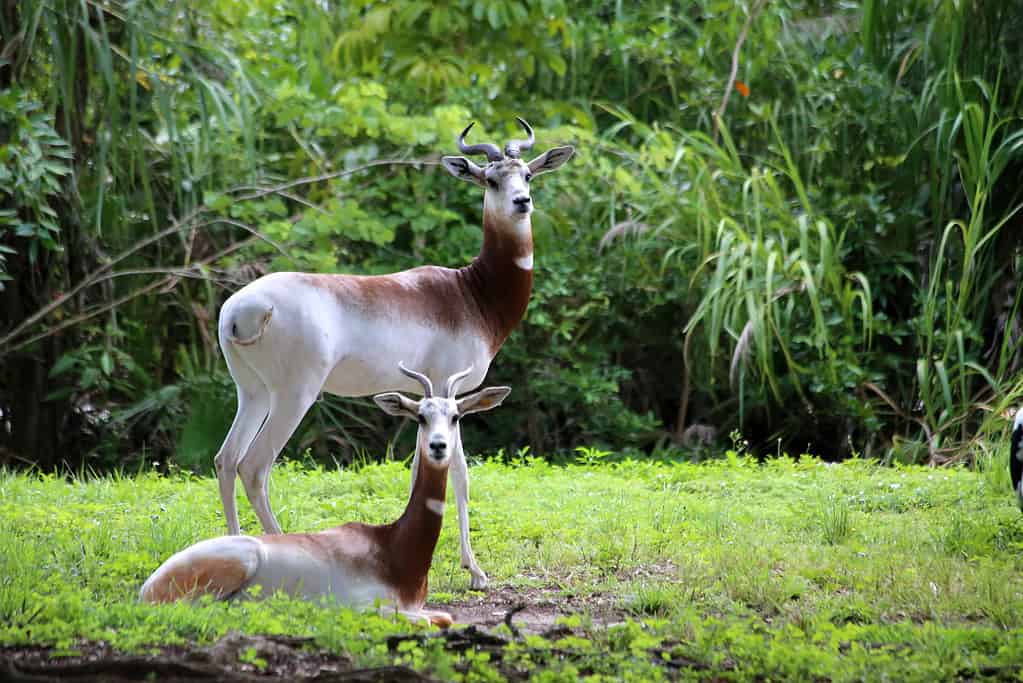
The dama gazelle, addra gazelle, Nanger dama, is a species of gazelle. It lives in
Africa
in the Sahara desert and the Sahel. Their natural populations only remain in Chad, Mali, and Niger.
©iStock.com/cuatrok77photograph
According to the Red List, the Dama Gazelle is listed as Critically Endangered. A desert animal, the gazelle is a member of the antelope family. Primarily found in the savanna woodlands and grasslands in Africa, they live in herds of eight to ten. While their speed helps escape from potential danger and predators, the main reason they are considered critically endangered is from being overhunted as well as habitat loss from competing livestock.
Since 1983, White Oak has been maintaining a breeding herd of Dama Gazelles. Their staff have become experts in the care and management of these gazelles, with more than 350 gazelle births since the program’s inception.
The company works with other zoos, and they participate in the Dama Gazelle Species Survival Plan, which is an AZA cooperative program with the goal of ensuring the species’ survival.
Eastern Bongo
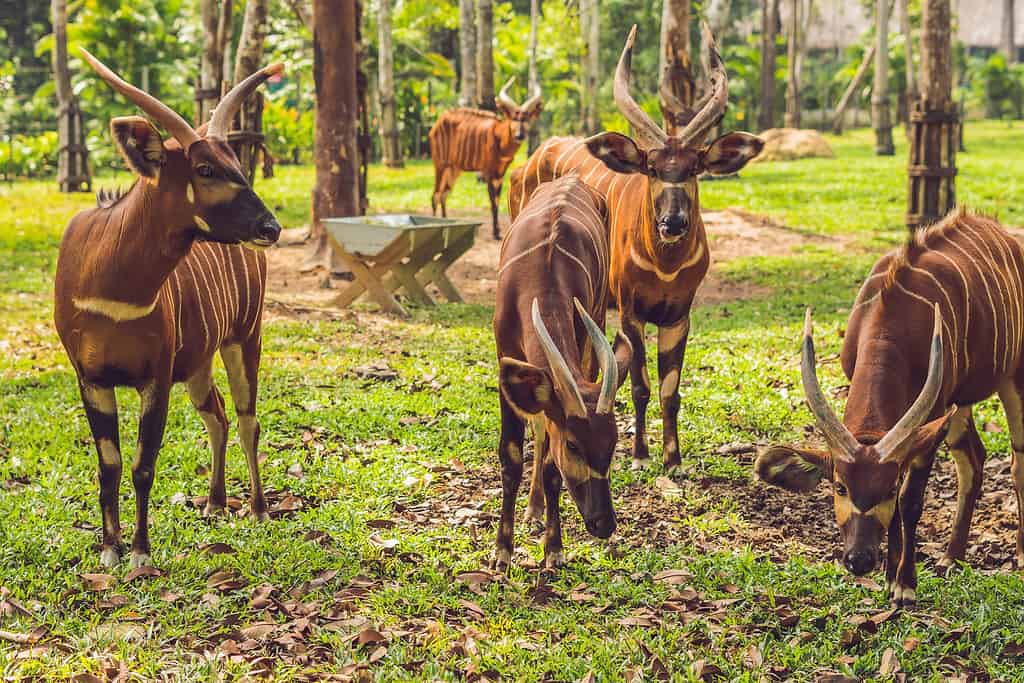
Eastern bongo are extremely rare animals that are most often in small groups. Photo by Getty Images.
©Elizaveta Galitckaia/Shutterstock.com
Just like the Dama Gazelle, the eastern bongo is critically endangered, with current estimates indicating there are fewer than 200 of the species remaining in the wild. Population numbers for the roaming bongo have declined dramatically over the past 40 years due to habitat loss and hunting escapades.
In 2004, White Oak facilities participated in a repatriation project that sent zoo-born animals back to Kenya. Included in the shipment were 18 bongo that were born at the facilities in Florida. Staff of White Oak accompanied the group of animals to a holding facility on Mt. Kenya while they were prepared for reintroduction into the forests and the wild.
Nile Lechwe

Currently endangered, the Nile lechwe species are natives of southern Sudan and southwestern Ethiopia.
©Kardaska/Shutterstock.com
Human conflict and suffering within the region of southern Sudan and southwestern Ethiopia have drastically affected the wildlife, specifically, the Nile Lechwe. According to the IUCN, these animals currently have a status of endangered.
Part of the waterbuck family of antelope, the lechwe are one of the most aquatic antelope species. With the lechwe accustomed to grassy river bottoms and meadows within swampy areas, White Oak’s lowland habitats provide the perfect location for the Nile lechwe.
Since the mid-1980s, the conservation park has maintained a strong herd, with many being born at the property.
Gerenuk
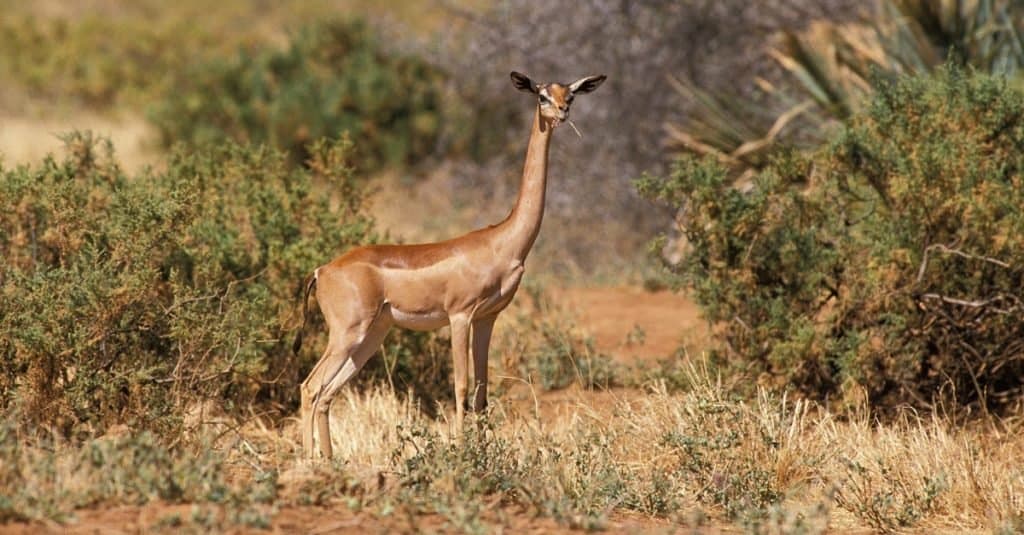
Gerenuk are also known as
giraffe
gazelle, for their noticeably long necks.
©slowmotiongli/Shutterstock.com
Also known as ‘giraffe gazelle’, the Gerenuk use their long necks and legs to their advantage when gathering food. This graceful animal can stand on its hind legs to pick leaves and buds from shrubs and trees.
Hailing from East Africa, Gerenuks are shy, live in small family groups, and have a unique diet. This combination is what made their care at White Oak a bit of a challenge. There wasn’t much information available pertaining to their daily food requirements. Because of this, the conservation center put in lots of effort to study their biology and habits.
Currently, the conservation center is in partnership with the US Department of Agriculture and the Ol Jogi Ranch located in Laikipia, Kenya. Along with White Oak’s partner, SEZARC, the companies are all in the process of developing processes and protocols to import frozen gerenuk semen collected from wild-caught males.
Birds at White Oak
Florida Grasshopper Sparrow

The Florida
Grasshopper
Sparrow can be found in the southern and central parts of Florida.
©iStock.com/BrianEKushner
This endangered species of bird was once quite commonly found among a widespread number of birds in 1902. But then by 2017, there were only about 15 pairs left in the wild. Because their grassland was turned into cow pastures, sod production, and other farming uses, the declining number of Florida Grasshopper Sparrows placed them into the endangered category.
White Oak became involved in the restoration of the Florida grasshopper sparrow count in 2016. Teaming up with the Florida Fish and Wildlife Conservation Commission and the U.S. Fish and Wildlife Service, 106 sparrows were released into the South Florida wild just three years later.
Whooping Crane
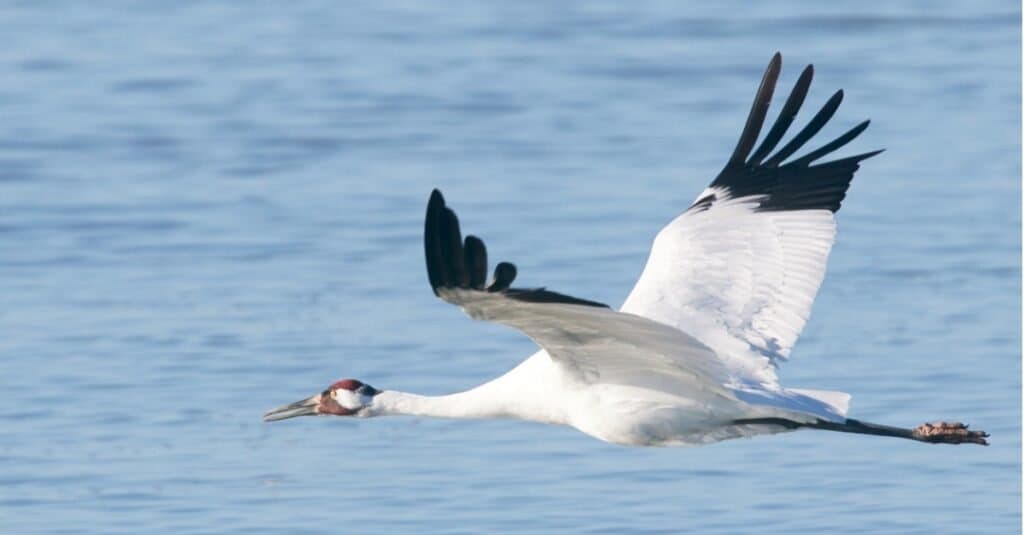
Whooping cranes are the rarest breed within the crane family.
©iStock.com/kellington1
Wisconsin-based International Crane Foundation reports there are fewer than 900 of these birds within North America. This speaks to those in the wild as well as in rescues and conservation centers. While that number is alarmingly low, it is impressive considering there were only 21 back in 1944.
Some fun facts about the Whooping Crane:
- They are the tallest bird in North America, reaching five feet in height
- They boast a wingspan of eight feet wide
- They fly with their necks stretched out in front of them
White Oak currently has five breeding couples of these cranes, and in 2018, two chicks were successfully hatched and raised within their family unit. That same year, the bird family was successfully released back into the wild at the Horicon National Wildlife Refuge in Wisconsin.
The conservation center felt confident working with the whooping crane, as they had gained success with other species of crane. Working with the Mississippi sandhill crane and the wattled cranes paved the road for working with the endangered whooping crane.
Wattled Crane
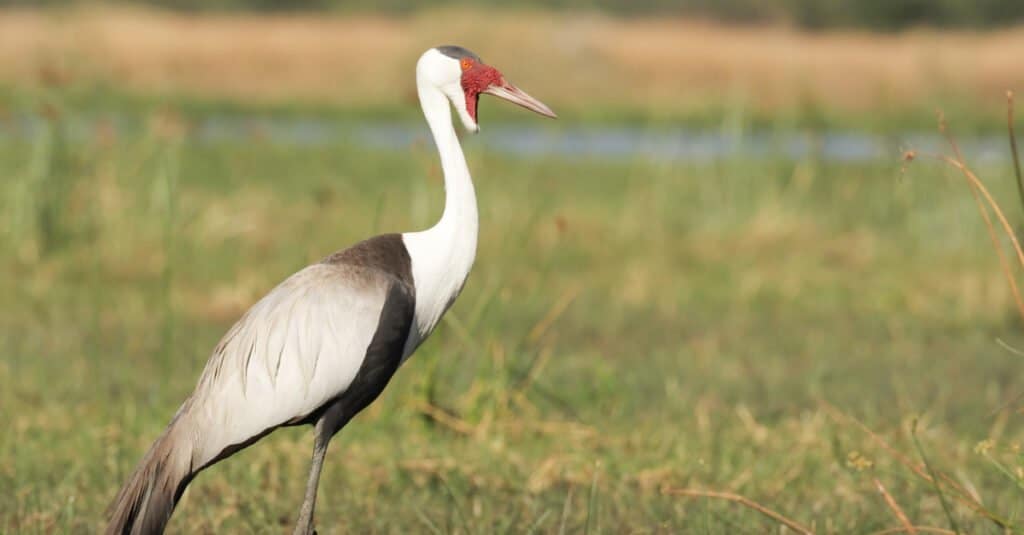
Wattled Cranes are found in the wilds of Sub-Saharan Africa.
©Bildagentur Zoonar GmbH/Shutterstock.com
This specific species of the crane family tends to be one of the largest. Furthermore, reaching heights just short of six feet, it is one of the tallest species of cranes.
Descriptors of this bird include its pale grey color, along with white feathered pendant wattles on its throat. In addition, the secondary wing feathers appear to be a long tail.
Sadly, the wattled crane is a threatened species, with a recorded count of only several thousand pairs. The crane is a social bird, often forming flocks and choosing to mingle around other birds and grazing mammals.
White Oak is collaborating with the Crane SSP and partners with such places as the Fossil Rim Wildlife Center, the San Diego Zoo Safari Park, the Wilds, and the Smithsonian Conservation Biology Institute.
Mississippi Sandhill Crane
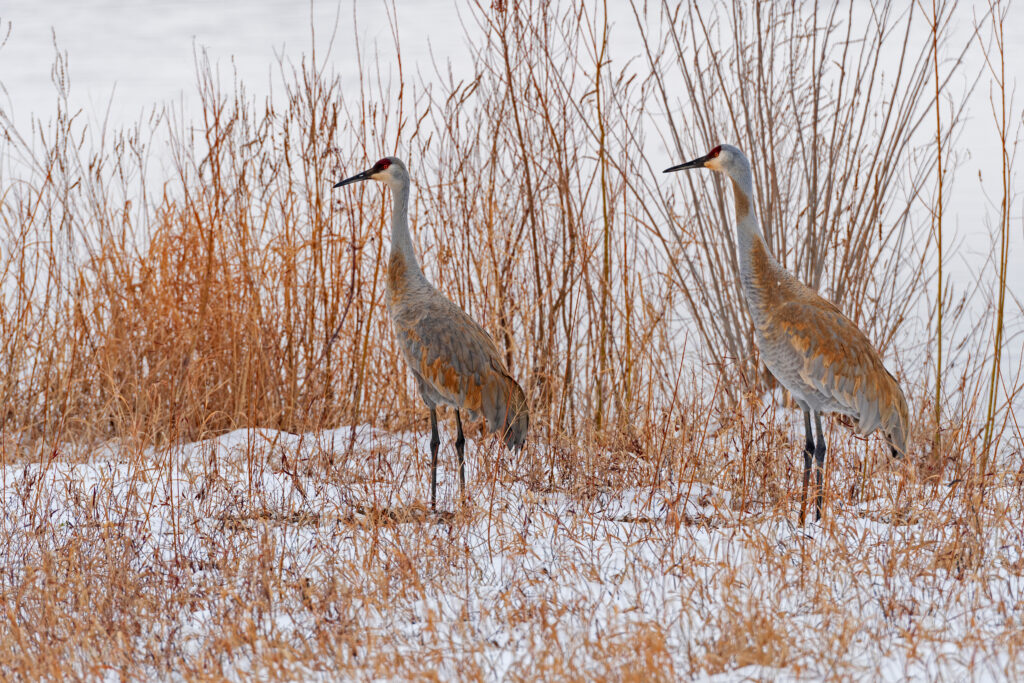
Sandhill Cranes are mainly endangered due to invasive plants and habitat destruction.
©Wildnerdpix/Shutterstock.com
While the sandhill crane is common throughout North America, there are two non-migratory sub-species of the sandhill crane local only to Mississippi and Florida. The Mississippi sandhill crane has dwindling numbers in population due to a loss of native habitat; pine plantations, land development, and invasive plant species have all played a part in the decline of these birds.
These critically endangered birds have been getting some help from White Oak since 1994. The conservation center designed special facilities for a captive breeding program for the cranes and because of it, several eggs and chicks have been produced each year. They are raised onsite and are part of the annual bird release at the Mississippi Sandhill Crane Wildlife Refuge.
The annual release from White Oak to the wildlife refuge near Gautier, MS., is critical to the cranes’ survival. Since 1995, the conservation center has raised and then placed 68 Mississippi sandhill cranes in the Mississippi Sandhill Crane Wildlife Refuge. The conservation center works to create techniques to increase the production of the Mississippi sandhill cranes while also paying attention to the health and fitness of the newly hatched birds. The goal is to release as many as possible annually to the Mississippi Sandhill Crane Wildlife Refuge.
Carnivores
Florida Panther

The
Florida panther
is the most endangered cat in North America.
©iStock.com/fotoguy22
The Florida panther has held low population numbers since the 1970s and even with the help of conservation centers such as White Oak, this big cat species aren’t out of the woods yet. The number of these majestic cats has grown from the 40 recorded back in the 70s to a still-low less than 200 in 2023.
Being at the top of the food chain, the panthers have no animal predators. However, the state animal of Florida is still in a fight for survival against mankind. Cars, condos, highways, and city expansion is destroying their natural environment. In the wild, male panthers consider their home base to be up to 200 square miles. They love to roam and with more and more natural environments being torn down to put up a parking lot, these solitary creatures are becoming more and more lost. The panthers’ largest cause of mortality is vehicle collisions.
White Oak has been rehabbing and releasing Florida panthers since 1986. During that first year, the conservation center released 19 rehabilitated panthers. Fast forward to 2018 and the company was able to release an entire panther family into the wild together for the first time.
And, in 2020, White Oak adopted two orphaned panther kittens from the ZooTampa. The seven-month-old kittens, Cypress and Pepper, had been hand-raised by the zoo after their mother was unable to care for them due to a mysterious neurological disorder. The pair will reside within the protective borders of White Oak for the remainder of their lives.
Vets and keepers at White Oak remotely monitor these big cats through cameras and radio telemetry collars as a way to ensure their health while reducing human contact.
Tiger
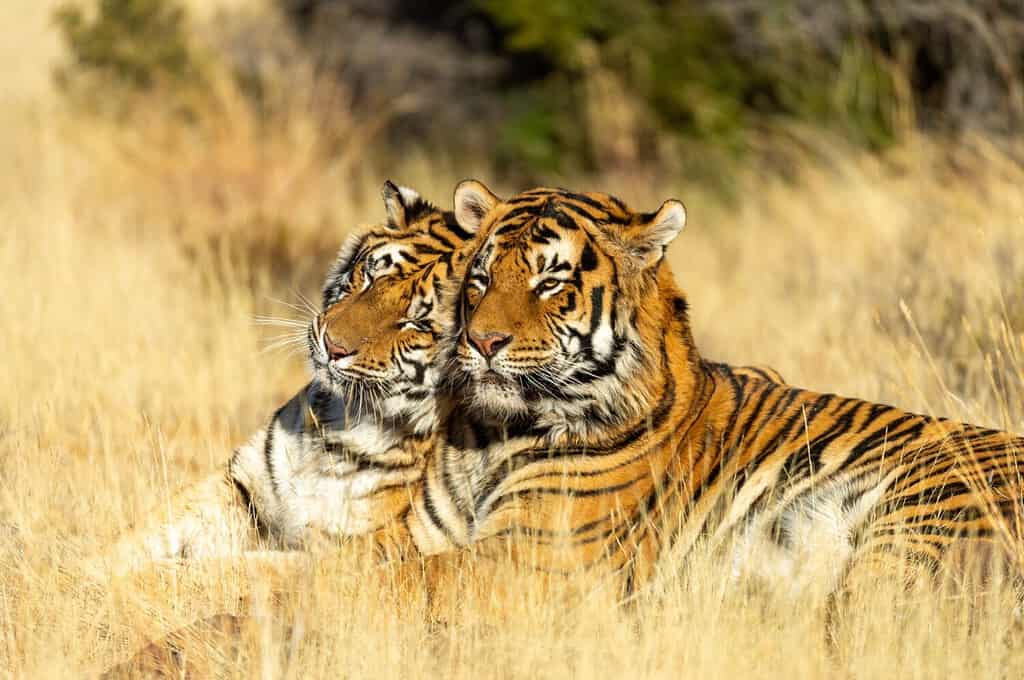
The largest of the big cats, male tigers can weigh up to 600 pounds, with a length of up to 13 feet.
©manfredstutz/Shutterstock.com
These
These large predators feed on prey as large, if not larger, than them. Water buffalo, pig, gaur, and deer are common victims of the tiger’s hunger. Naturally roaming cats, male tigers have large territories that can overlap several female tigers’ homes.
It is thought that there are fewer than 3,500 tigers remaining in the wild. Currently, they are found in locations throughout Southeast Asia, South Asia, Russia Far East, and China. Poaching still creates the biggest threat to these beautiful cats. While the coat is thought of as a status symbol, many Asian cultures seek all parts of the tiger for traditional medicine as well as folk remedies.
At White Oak, two young male tigers share a riverine habitat with the Indian rhino. In the wilds of Nepal and India, it is very natural for these two species to live peacefully among each other. Guests visiting the conservation center have the opportunity to learn about these young tigers’ journey and future.
Rhino
White Oak offers a protected environment for three of the five remaining rhino species: the Southern Black Rhino, the Southern White Rhino, and the Greater One-Horned Rhino.
Southern Black Rhino
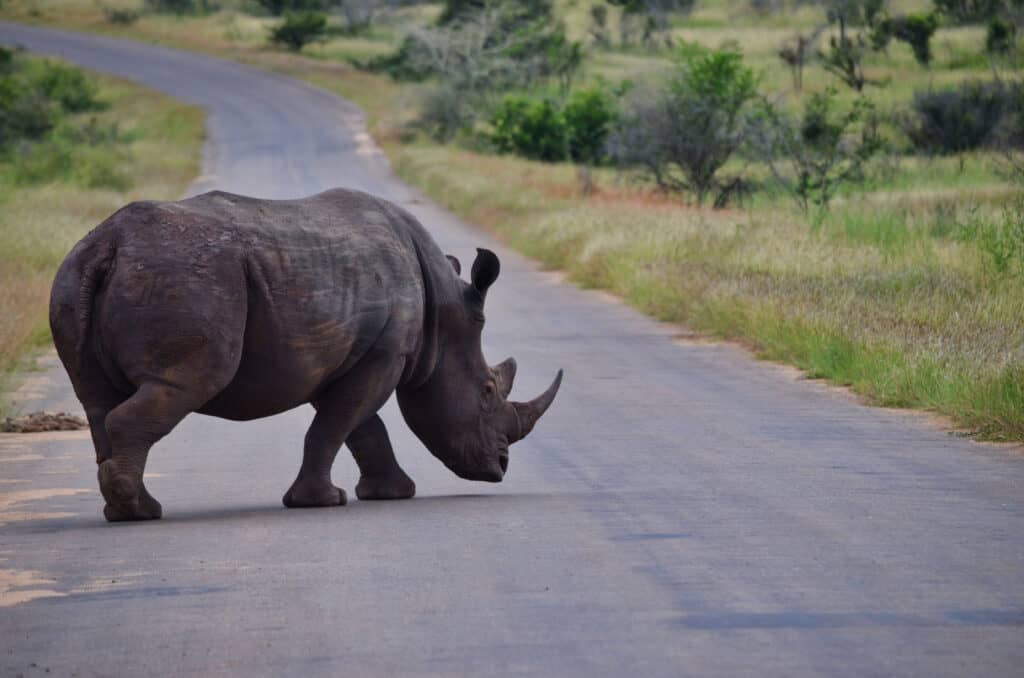
Black rhinos are ‘browsers’ searching for leaves and berries for meals.
©Ganz Twins/Shutterstock.com
Poached for their horns, for reasons such as medicinal or decorative purposes, the Southern Black Rhino has a status of Critically Endangered by the IUCN. A similar sub-species of the black rhino, the western black rhino, became extinct in 2011.
Black rhinos from Zimbabwe arrived at White Oak in 1993. The conservation center was excited to announce the birth of a black rhino in December 2020. Named ‘Rocky’ after the movie boxing star, he weighed in at 70 pounds at birth, with his weight jumping to 250 pounds by four months.
Other Species at White Oak
Pѐre David’s Deer

Père David’s Deer is named after Armand David, a French missionary from China.
©Peter O’Connor aka anemoneprojectors /CC BY-SA 2.0 – License
This species of deer is currently listed as being extinct in the wild by the IUCN. The numbers dropped so low by the late 1800s and into the early 1900s due to heavy hunting efforts. Due to some private deer collections in France, the United Kingdom, and Germany, the breed was saved from total extinction.
The remaining deer were brought to Woburn Abbey in England and a breeding herd was formed. Over the next century, the population grew due to the efforts of breeding programs around the world.
Within conversation centers such as White Oak, the breed lives in the same multi-species habitat along with the Greater One-horned rhino.
This specific deer is a large deer, standing up to four feet tall at the shoulder; they can weigh up to 400 pounds. Large eyes and branched antlers are unique characteristics for the males. Known as good swimmers, the deer will spend lots of time standing in waters that reach their shoulders.
Pѐre David’s Deer have reddish coats during summer seasons, with a change to a dullish-gray throughout the winters. Similar to reindeer, these deer produce a clicking sound while walking. Additionally, they have a life span that reaches up to 18 years.
Okapi
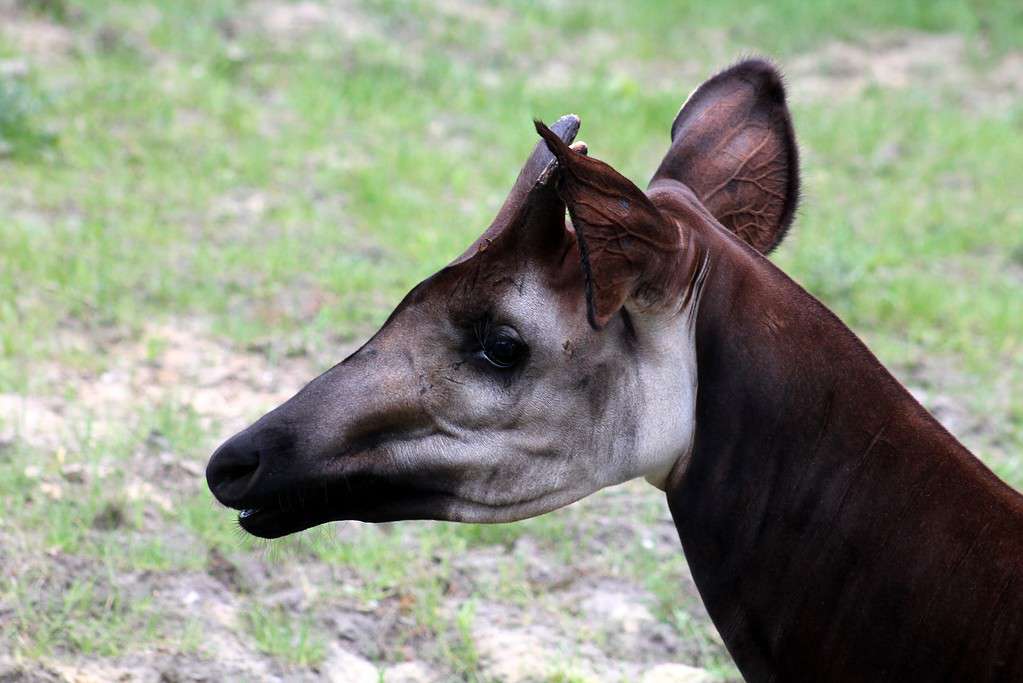
The okapi is native to the rainforests of the Democratic Republic of the Congo.
©CC BY-SA 4.0 – License
With unique markings and a mixture of colors, the okapi are easily recognizable. While the stripes might lead many to label this animal as a zebra, it is actually a forest giraffe species.
The okapi munch on a variety of plants and lead solitary lives. In the wild, they are only found in Central Africa’s rainforests of the Democratic Republic of the Congo.
Okapi within zoos across the United States, Japan, and Europe work together alongside the Okapi Conservation Project. Their work provides critically valuable annual support for the protection of the Okapi Wildlife Reserve.
Additionally, through White Oak’s care and preventive measures, the okapi are thriving and receive the needed care at dedicated facilities by trained specialists.
Somali Wild Ass

The Somali Wild Ass is one of the rarest wild equids with less than 200 animals thought to remain.
©iStock.com/Thorsten Spoerlein
Listed as critically endangered by the IUCN, the Somali wild ass are killed for food as well as traditional medicines. Threats from domestic farm animals also happen, as sparse water resources and desert grass create competition.
White Oak added a herd of Somali wild ass to the conservation center back in 2008 and is one of five locations within the United States that currently breeds this species. The conservation center works closely with its zoo partners to ensure that a strong sustainability program is always active.
Since their arrival at White Oak, there have been 20 Somali Wild Ass foals born.
Asian Elephant

Elephants are beautiful animals that are quite social.
©ElephantErik/Shutterstock.com
White Oak built a 2,500-acre habitat for these endangered gentle giants, allowing for plenty of space for roaming, playing, and foraging. Complete with 11 watering holes, three barns that feature high-tech vet equipment, and a setup to nurture both the physical surroundings and social abilities of the Asian elephants. The conservation center brought in an expert team to tend to just this species.
Asian elephants have an IUCN Status of Endangered, with the species having disappeared from 95% of their historical range. They are known to be quite family-orientated and are social animals, always staying in large herds.
The photo featured at the top of this post is © iStock.com/cuatrok77photograph
Thank you for reading! Have some feedback for us? Contact the AZ Animals editorial team.






